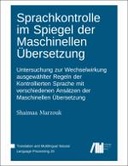Explore

Sprachkontrolle im Spiegel der Maschinellen Übersetzung
Shaimaa Marzouk
2022
0 Ungluers have
Faved this Work
Login to Fave
Examining the general impact of the Controlled Languages rules in the context of Machine Translation has been an area of research for many years. The present study focuses on the following question: How do the Controlled Language (CL) rules impact the Machine Translation (MT) output individually? Analyzing a German corpus-based test suite of technical texts that have been translated into English by different MT systems, the study endeavors to answer this question at different levels: the general impact of CL rules (rule- and system-independent), their impact at rule level (system-independent), their impact at system level (rule-independent), and at rule and system level. The results of five MT systems (a rule-based system, a statistical system, two differently constructed hybrid systems, and a neural system) are analyzed and contrasted. For this, a mixed-methods triangulation approach that includes error annotation, human evaluation, and automatic evaluation was applied. The data were analyzed both qualitatively and quantitatively based on the following parameters: number and type of MT errors, style and content quality, and scores from two automatic evaluation metrics. In line with many studies, the results show a general positive impact of the applied CL rules on the MT output. However, at rule level, only four rules proved to have positive effects on all parameters; three rules had negative effects on the parameters; and two rules did not show any significant impact. At rule and system level, the rules affected the MT systems differently, as expected. Some rules that had a positive impact on earlier MT approaches did not show the same impact on the neural MT approach. Furthermore, the neural MT delivered distinctly better results than earlier MT approaches, namely the highest error-free, style and content quality rates both before and after the rules application, which indicates that the neural MT offers a promising solution that no longer requires CL rules for improving the MT output, what in turn allows for a more natural style.
This book is included in DOAB.
Why read this book? Have your say.
You must be logged in to comment.
Rights Information
Are you the author or publisher of this work? If so, you can claim it as yours by registering as an Unglue.it rights holder.Downloads
This work has been downloaded 43 times via unglue.it ebook links.
- 43 - pdf (CC BY) at Unglue.it.
Keywords
- artificial intelligence
- Computer science
- Computers
- Computing & information technology
- Natural language & machine translation
- Natural Language Processing
Links
DOI: 10.5281/zenodo.7031898Editions

